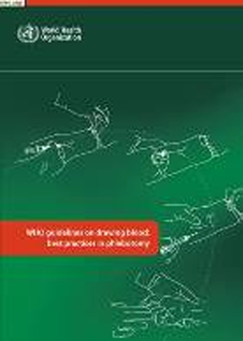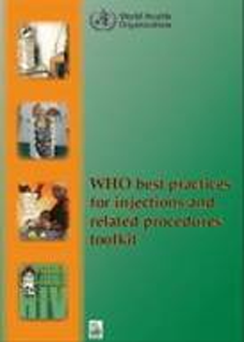Resource Center
Injections are the most common health care procedure worldwide. In developing and transitional countries alone, some 16 thousand million injections are administered each year. I Most injections, more than 90%, are given for therapeutic purposes while 5 to I 0% are given for preventive services, including immunization and family planning. The majority of therapeutic injections in developing and transitional countries are unnecessary. A safe injection does not harm the recipient, does not expose the health care worker to any avoidable risk and does not result in waste that is dangerous for the community. When injections are medically indicated they should be administered safely. Unsafe injections place patients at risk of disability and death. Reuse of injection devices without sterilization is of particular concern as it may transmit hepatitis B virus (HBV), hepatitis C virus (HCV) and human immunodeficiency virus (HIV), accounting for 30%, 41 % and 5% of new infections in 2000, respectively. In addition, inappropriate and unhygienic use of multi-dose vials may transmit blood borne pathogens.
Sterile single use injection devices are widely available at low cost. Sterile, single use injection devices include sterile hypodermic syringes, sterile hypodermic needles, auto-disable syringes for immunization purpose, syringes with a reuse prevention feature for general purpose and syringes with needle-stick-prevention features (e.g., safety syringes) for general purposes.
When someone pricks themselves with a used needle, this is known as a needle stick injury. Tragically, they are an extremely common form of occupational injury for healthcare providers. Needle stick injuries are preventable, through a combination of better training, safer product, and effective regulation.
We have for your benefit tried to collect a few information materials for your reading and reference on safe use of syringes and prescribed guidelines for their safe use and prevention of re-use. All documents/pdfs/power point presentations and videos have been picked from sources available for public viewing and the source has been duly acknowledged.
Also visit the following links to get more information on this topic:
British Medical Association
https://www.bma.org.ukInternational Sharps Prevention Society
http://www.isips.orgUK Health and Safety Executive, Needle stick Injuries
http://www.hse.gov.uk/healthservices/needlesticksFrontline Foundation, Against Occupational Risks to Healthcare Workers
http://frontlinefoundation.orgAssociation of British Healthcare Industries
http://www.abhi.org.ukEvery year, all over the world, millions of men, women and children are needlessly infected as a result of unsafe injection practices. Unskilled personnel working in unhygienic settings too often unwittingly pass on infectious blood borne diseases through the re-use of insufficiently sterilized needles and/ or syringes. In many cases, health care workers will merely rinse equipment in a pot of soapy water between injections or dispense with such measures altogether. According to the Safe Injection Global Network (SIGN), the proportion of injections administered with unsterilized equipment range from between 1.2% in industrialized nations to an alarming 75% in transitional or developing countries.
Injection Safety
WHO Guidelines on drawing blood: Best practices in phlebotomy
Phlebotomy uses large, hollow needles to remove blood specimens for lab testing or blood donation. Each step in the process carries risks – both for patients and health workers. Patients may be bruised. Health workers may receive needle-stick injuries. Both can become infected with bloodborne organisms such as hepatitis B, HIV, syphilis or malaria. Moreover, each step affects the quality of the specimen and the diagnosis. A contaminated specimen will produce a misdiagnosis. Clerical errors can prove fatal.
The new WHO guidelines provide recommended steps for safe phlebotomy and reiterate accepted principles for drawing, collecting blood and transporting blood to laboratories/blood banks.
UNICEF Reports
WHO best practices for injections and related procedures toolkit
Medical treatment is intended to save life and improve health, and all health workers have a responsibility to prevent transmission of health-care associated infections. Adherence to safe injection practices and related infection control is part of that responsibility – it protects patients and health workers.
Unsafe injections can result in transmission of a wide variety of pathogens, including viruses, bacteria, fungi and parasites. They can also cause non-infectious adverse events such as abscesses and toxic reactions. Reuse of syringes or needles is common in many settings. It exposes patients to pathogens either directly (via contaminated equipment) or indirectly (via contaminated medication vials). The risks of unsafe injection practices have been well documented for the three primary bloodborne pathogens Download Document- human immunodeficiency virus (HIV), hepatitis B virus (HBV) and hepatitis C virus (HCV).
A safe injection is one that does not harm the recipient, does not expose the provider to any avoidable risks and does not result in waste that is dangerous for the community. Unsafe injection practices can lead to transmission of bloodborne pathogens, with their associated burden of disease.
The purpose of this toolkit is to promote implementation of safe practices associated with the following medical procedures:
- intradermal, subcutaneous and intramuscular needle injections;
- intravenous infusions and injections;
- dental injections;
- phlebotomy; and
- lancet procedures
More Documents
Injections are skin-piercing procedures performed with a syringe and needle to introduce either a curative substance or a vaccine into a patient. This can be achieved through one of three routes:
- intramuscular – into a muscle
- intravenous – into a vein
- subcutaneous – beneath the skin
This excludes all other skin-piercing procedures such as blood transfusions, surgery, tattoos and body piercing. An unsafe injection is one that causes harm to the patient (e.g. caused by unsterilized equipment), the provider (e.g. a needle-stick accident during disposal) or the community (e.g. scavenging through rubbish). An unnecessary injection is one where oral alternatives are available, where the injected substance is inappropriate or harmful or where the symptoms of diagnosis do not warrant treatment by injection.
More Documents
Guiding Principles to ensure injection device security
(Source: WHO)Harm Reduction and Sterile Syringe Access
(Source: New Jersey Syringe Access Informational Forum)Immunization at a glance
(Source: WHO)Overview of safe injection facilities
(Source: Alliance for Saving Lives)Risk Management in Medical Laboratories
(Source: UNICEF)Reuse of syringes is one of the major problems facing preventive and curative healthcare in the world. Many countries have syringe reuse rates of 50% and more. Whether unintentional due to poor understanding of risks, or intentional due to greed or supply shortages, the practice of reusing syringes causes significant transmission of diseases such as HIV, Hepatitis B, and Hepatitis C. People being treated for one disease may be inadvertently given another, more harmful disease.





